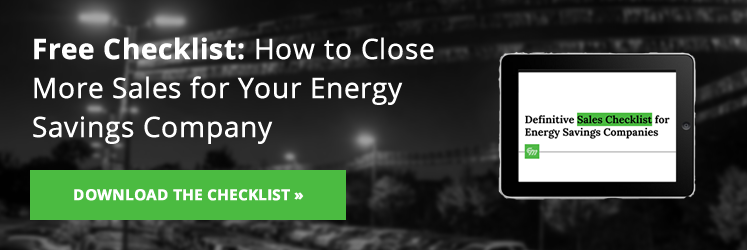Financing options for energy-efficient upgrades and projects have been few and far between the last several decades. However, that is starting to change as of lately. Below you'll discover how you can overcome a lack of budget or present cash to progress with your proposed energy efficiency project.
Lack of budget is the number one reason energy efficiency projects don’t get approved.

Energy efficiency projects require upfront investments, which many business owners have not budgeted. As a result, many projects don’t move forward due to lack of available capital, despite often-impressive ROIs and short payback periods.
Using credit to finance equipment purchases is standard practice for business owners, but it is not commonplace with energy efficiency equipment (like lighting) investment proposals because most resellers are not familiar enough to offer it.
Benefits of Offering Financing for Energy Efficiency Projects
- Financing energy efficiency projects will shorten your sales cycle—sell the net profit and savings generated by the equipment (ROI)
- You’ll have more control of the LED Lighting sale when it’s financed
- Financing energy efficiency projects offers convenience to your customers—customers perceive it to be a value-add that you have a finance program.
- Use financing to “trial close,” it may help uncover hidden customer objections to an LED lighting project
- Financing helps overcome sticker shock of the price of an LED lighting project
- Increase Margins – Earn up to an additional 5% on each transaction of an LED lighting project
What Are The Main Ways To Finance an Energy Efficiency Project?
TRADITONAL FINANCING
There are many traditional financing options for energy efficiency projects. If structured properly, an energy savings project can be financed similar to a car payment or home mortgage. If you decide to finance a project with a loan, bond, true lease, capital lease or other leasing variation, there are many new vocabulary words to learn. You may have to get accountants involved and consider things like depreciation (and how to label equipment to enable a faster depreciation schedule). Note that the tax laws regarding depreciation have changed for 2016.
Operating Lease
Operating leases have more of a traditional lease structure with fixed payments, minimal or no upfront costs and end-of-lease purchase, return or re-lease options. For building owners interested in obtaining use of the energy efficient equipment, similar to how they might lease a copier for their business, operating leases may be the best option. Operating leases are off-balance sheet structures that involve making lease payments as a standard operating expense with no ownership of the asset by the end user (lessee) during the lease term. At the end of the lease term, a lessee may purchase the asset at the fair market value, return the equipment, or renew the lease for a new term. This helps the building owner preserve their corporate line of credit as well as any cash they may have set aside for other business needs. They’re often preferred because payments can be made from the operating budget, which can remain on the off-balance sheet vs. capital budget.
Capital Lease
For the building owner who prefers to enjoy the tax and depreciation benefits of ownership of the assets without actually owning the energy efficiency project assets, a capital lease may be the best financing vehicle. A capital lease is more like a loan than a lease, because they have fixed terms and monthly payments with $0 down. Many lease providers let soft costs (engineering, install etc.) be funded through the lease. In terms of the business owner’s balance sheet, the equipment would need to be recorded as a capital asset and the lease payments would be recorded as a liability. At the close of the lease contract term, the energy efficient equipment transfers ownership to the business owner for a nominal purchase price, usually $1.
Finance Agreement
A finance agreement, or a regular debt or loan agreement, is most similar to a capital lease in length of loan term, and in lending to the credit of the building owner rather than lending to the value of the asset. However, a major distinction is that the business or building owner owns the equipment outright, and is not a lessee. All tax and depreciation benefits reside with the building owner.
How Financing an Energy Efficiency Project Works
The key to utilizing these financing options for energy-efficiency projects, and other types for that matter, is to structure the project such that the lease or debt payments on a monthly basis are less than estimated energy savings. This allows the customer to see the benefits of energy savings while making the lease or debt payments over time without the need to dip into their line of credit or other capital reserves just to fund this project.
Start Saving Money Immediately
Electro-Matic can work with energy efficiency project developers to make sure that this structure is in place so that at the end of the day, the building owner is not paying any more money out of pocket than if they do not implement the project. This concept of energy savings covering the cost of the financing is of strategic importance to both the developer and the building owner; the building owner can preserve its cash and credit for business operations while the developer can get the project done. Additionally, since the building/business owner is not using his own cash or credit to finance the deal, more energy efficiency projects across other properties can be implemented, through financing again or through self-funding. Had the building owner self-funded the first deal, there would be less of an opportunity for them or the project developer to explore implementing energy efficiency projects at the building owner’s other locations.
What Size of Energy Efficient Upgrades Should be Financed?
The projects that quality for finance agreements and capital or operating leases typically run in the $100,000 to $10 million (majority in the $100,000 – $250,000) range, but can be as low as $10,000. The credit application process is typically a one to two page application with a one to two day response. Here is a great way to present the different options for proposal when making your presentation.
Capital Lease Example in Energy Efficiency Projects
The most commonly utilized lease in energy efficiency financing is the capital lease, also known as “lease-to-purchase.” Typically, the capital lease has $0 or minimal down payment, monthly payments structured over a term of 3-5 years, and a $1 buyout provision at the end of the term.
Energy-Efficient Lighting Upgrade Example
Any town USA Company needs to update its lighting to a new more efficient system. The project cost is $100,000 with expected annual savings of $50,000. This translates to a simple payback on the investment of 2 years. Despite the large energy and dollars savings potential, Any town USA Company sees the $100,000 investment as funds not available to launch its new product offering that will produce additional revenue for the company.
Green Developer brings a capital lease financing option to the table under the following terms: 3-year lease, $0 down payment, $100,000 amount financed and monthly payments of $3,214. Monthly savings equate to $4,167. The monthly savings more than covers the monthly financing payment, making this project cash flow positive by $953 per month from day 1. In the end, Any town USA Company reserved its cash to invest in its core business, but also reaped the benefits of the lighting upgrade – a win-win!
Advantages of Financing Energy Efficiency Projects
With these three types of financing situations, there are several advantages for the building owner. Lease payments are typically set to match estimated energy cost savings providing net positive cash flow with little or no up-front cost. There is also the potential for the building owner to capture tax benefits (capital lease) or receive lower rates due to the lender capturing tax benefits (operating lease). The building owner may also be given the option of deducting monthly lease payments as an operating expense.
Another advantage in choosing from a capital lease or operating lease is that it provides the building owner with the ability to customize the terms depending on particular needs and ability to capture tax benefits. Lastly, the building owner has preserved its working capital line, cash reserves, or other available business credit for business needs rather then spending on the retrofit.
Things to Consider When Offering Financing for Energy Efficiency Projects
As with any project, there are options to consider when you are choosing financing. With these financing options for energy efficiency projects, each may create balance sheet or debt concerns, particularly with a capital lease or finance agreement. In summary, lease and finance agreements are simple options to finance energy efficiency equipment, and they are vehicles that CFOs know and use.
Tools To Start Financing Your Energy-Efficiency Project
- Lease Menu
- Tiered Rate Proposal
- ROI Profit Generator
- Finance Application
- 2016 IRS Section 179 Calculator
- Energy Performance Contracts – Working with an ESCO
Selecting the Best Option for Financing Your Energy Efficiency Project
| Project Investment | Energy Efficiency (Lights, Controls, HVAC, etc.) | Distributed Generation (Solar, Wind, etc.) |
| <$100,00 |
Capital Lease PACE if in Region |
Capital Lease Pace if in Region |
| $100,000–$500,000 |
Capital Lease PACE if in Region Operating Lease |
Capital Lease PACE if in Region Operating Lease |
| >$500,000 |
PACE if in Region Operating Lease EPC |
PACE if in Region Operating Lease PPA |
On-Balance Sheet
Project asset and liability must be listed on the company’s balance sheet when using on-balance sheet financing. For example, using a commercial loan to purchase equipment would be a liability (the loan obligation) and the assets (the equipment) are added to the balance sheet. Many property owners/CFOs will have a preference; you should know what that is so you can bring suitable options to the table.
Off-Balance Sheet
Off balance sheet means that the project asset and liability are not listed on the company’s balance sheet, such as an operation lease where payments are made from the operating budget and the equipment is effectively rented, not owned by the property owner. For some owners/CFOs, this is important for various reasons (such as affecting lending ratios). It’s not important that you understand why someone prefers on-balance sheet versus off-balance sheet, it’s only important that you understand which financing options fall into which category.
Other Financing Options for Energy Efficiency Projects
Performance Contracting
Performance contracting has been around for decades and allows projects to be developed by an Energy Service Company (ESCO) that will offer a “performance guarantee” on the savings, such that the savings are greater than the finance payment (usually handled by another third-party). PC is more common with government, institutional and educational facilities because financiers are more comfortable lending money to organizations that are likely to survive a recession or other business cycles. Thus, performance contracting has its limitations. In addition, contracts can become complex (for both the ESCO and the facility) and it takes time understand them as well as get legal endorsement.
New Funding Options for Energy Efficiency Projects
Additional project funding options have become available in recent years such as Utility Energy Service Contracts (UESC), Power Purchase Agreements (PPA), On-Bill Financing and Property Assessed Clean Energy (PACE) financing. There is a lot to say about all of these options, but below is a quick summary:
Utility Energy Service Contracts
Utility Energy Service Contracts are basically performance contracts that are developed and implemented by the utility servicing an energy consumer. This offers some streamlining as the utility can provide the funding for project development and make the deal cash flow neutral to the consumer, with fewer hassles.
Power Purchase Agreements
Commonly used for solar PV or wind—sometimes lighting is added as measure. The PPA allows a building to put solar on the roof at no upfront cost, when they agree to purchase the kWh produced for a long-term contract. Hopefully, the PPA is structured so that the consumer is paying about the same price for the solar kWhs as they do from the grid. This works well when the grid price is high, the utility is cooperative and there are local incentives.
On-Bill Financing
Offered by some progressive utilities (it is usually part of a Demand Side Management Strategy that benefits the utility). As the name implies, the consumer repays the installation costs with an extra charge on their future utility bills. The deal is structured so that the monthly savings are larger than the extra charge. The improvement can be “linked” to the meter, so that if the consumer moves out of the building, the savings and the repayment are owned by a new consumer.
PACE
Property Assessed Clean Energy is very similar to the on-bill financing concept, except the savings and repayment are “linked” to the property tax, so that if an owner sells a property, the new owner would assume the property tax “amendment” (extra payment), but the new owner also gets the savings cash flow. In the past few years, PACE has become very popular, enabled by legislation in 31+ states. See if your local community offers the program. PACE is ideal for deep retrofits on facilities where property owners may not have access to commercial loans or other financing.
Energy Performance Contracts (EPC)
Projects to be developed by an Energy Service Company (ESCO) that will offer a “performance guarantee” on the savings, such that the savings are greater than the finance payment (usually handled by another third-party). The ESCO conducts a comprehensive energy audit for the facility and identifies improvements to save energy. Contract for a period not to exceed 25 years.
Available Energy Efficiency Rebates
These options can also assist with funding. For example, Utility A will give a $10 rebate on LED lamps that cost $20… that is basically subsidizing 50% of the material cost. A list of free rebates and other incentives (tax credits, etc.) is available. We highly suggest getting to know your local programs and become “Trade Ally’s” to get added promotional information and sales tools.
Ultimately, financing is a tool to get more projects implemented, but we need to focus on it because it is a solution to the largest barrier to energy management projects. It is clear that the number of energy financing options has exploded, leaving more choices for the facility manager or owner.
There are a lot of options here and may take some experience to get the hang of it. Check our Quick Guide to Project Financing for easy reference (link to Quick Guide).
Don’t have time or background in finance to apply for financing? Electro-Matic can help. We can work with you to get the financing that’s right for you.
Email: ammartinez@electro-matic.com


